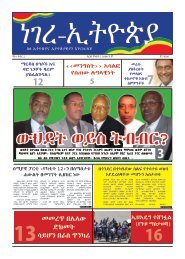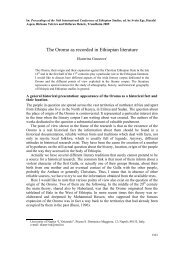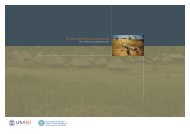MatabelelandReport
MatabelelandReport
MatabelelandReport
Create successful ePaper yourself
Turn your PDF publications into a flip-book with our unique Google optimized e-Paper software.
Most common beating technique: People would be forced to lie face down on the ground, and then would be repeatedly<br />
beaten, often for several hours, with thick sticks or gun butts.<br />
Most common complaints:<br />
Permanent back\arm\leg\neck\hand aches, inhibiting any heavy work.<br />
Fractured fingers\arms and other bones<br />
Permanent scarring of buttocks and back<br />
Recurring headaches, dizziness and high blood pressure<br />
Permanent eye damage and hearing disorders<br />
Jaw damage including loss of teeth<br />
Permanent uterine disorders<br />
Permanent kidney damage, also male impotence<br />
For a region by region breakdown on all offences, see Summary following the Village by Village Reports, page .<br />
5.THE VILLAGE BY VILLAGE SUMMARY - DETAILING OF INCIDENTS ACCORDING TO TIME AND<br />
PLACE.<br />
NOTE:<br />
Numbers in brackets: indicate source numbers of BLPC interviews from which information was derived.<br />
** indicates source document is in a CCJP file<br />
**** indicates an incident involving dissidents. For all other incidents, the perpetrators are identified as Army units or<br />
other Government agencies such as the Central Intelligence Organisation (CIO), or Police Support Unit (SU).<br />
5 Brigade (5B) may be assumed as the perpetrator unless another unit is mentioned.<br />
Tsholotsho has been roughly divided up into four regions for this section, each one being an area within the vicinity of<br />
known 5 Brigade Base Camps. In practice some villages were affected by more than one of these units, and in early<br />
1983 the far south of Tsholotsho was probably affected by the unit based in Tsholotsho, as the one at Mbamba Camp<br />
appears to have been established later in 1983. The four regions are:<br />
1) Pumula Mission, covering the whole western area and much of the south.<br />
2) Mbamba/Nanda, in the extreme south and east<br />
3) Tsholotsho town and the central part of Tsholotsho, west towards Dhlamini Rest Camp.<br />
4) Gwayi/Sipepa region, in northern Tsholotsho.<br />
The spellings of names of "villages" or "lines" have been standardised in accordance with the 1975 Surveyor<br />
General's map of the Nyamandlovu region (Sheet SE-35-15).<br />
5.1.PUMULA MISSION AREA (WEST TSHOLOTSHO)<br />
In general, this seems to have been very badly affected by 5 Brigade, who set up camp close to the Mission, from late<br />
January 1983. From interviews, it is clear that many settlements within a very wide radius of the mission experienced<br />
mass beatings, or were burnt to the ground because villagers had fled the area.<br />
A few parts of this area, to the west of the Mission ( eg Korodziba, Soloboni), have been entirely resettled since the<br />
early eighties, so reports on 5 Brigade activities here trickle in from other locations in Tsholotsho, wherever people have<br />
been resettled to. Fortunately, events around Pumula Mission were well documented by CCJP, and File H also has<br />
comprehensive accounts of events in some villages. It has therefore been possible to place those few interviews which<br />
lack detail in context within the broader data framework.<br />
56







